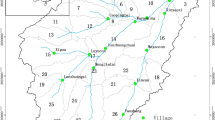Abstract
Mitigation works are very essential for mitigation of debris-flow hazards in mountainous areas. Usually, it is difficult to assess the effectiveness of existing mitigation works in a catchment. This paper presented a method for quantitative assessment of debris flow mitigation measures by using Kanako system, a user-friendly GUI-equipped debris flow simulator that allows good visualization and easy interpretation. Kanako 2D (Ver. 2.04) was applied to a case study at Caijia Gully, Sichuan Province, China. Mitigation works including check dams, drainage channel, and deposition basin were constructed in the gully in 2001 and 2006. Kanako 2D can simulate debris flow from steep area to alluvial fan. 1D simulation was applied for assessing the effect of the check dams at the lower part of the gully, and 2D simulation was applied for the effect of the drainage channel and deposition basin on the alluvial fan. The simulation results indicate that debris flow will cause great damage to residential area on the alluvial fan if mitigation measures were not implemented in the gully. For old dams which have been filled up with deposits of previous debris flows, the results show that they still have the function for controlling debris flow due to the gradient reduction of the channel bed in front of the dams by the trapped debris flow deposition. After the comprehensive control of debris flow including trapping, drainage, and deposition in the gully, the simulation results indicate that the risk on the alluvial fan can be reduced to an acceptable level.

















Similar content being viewed by others
References
Fei X, Shu A (2004) Movement mechanism and disaster control for debris flow. Tsinghua University Press, Beijing (in Chinese)
Han WB, Ou GQ (2006) Efficiency of slit dam prevention against non-viscous debris flow. Wuhan University Journal of Natural Sciences 11(4):865–869
Hassanli AM, Nameghi AE, Beecham S (2009) Evaluation of the effect of porous check dam location on fine sediment retention (a case study). Environ Monit Assess 152(1–4):319–326
Hu KH, Ge YG, Cui P (2010) Preliminary analysis of extra-large-scale debris flow disaster in Zhouqu County of Gansu Province. J Mt Sci 28(5):628–634 (in Chinese with English abstract)
Ikeya H (1989) Debris flow and its countermeasures in Japan. Bull Eng Geol Environ 40(1):15–33
Jakob M, Hungr O (eds) (2005) Debris-flow hazards and related phenomena. Springer Praxis, Heidelberg
Kang ZC, Li ZF, Luo JT (2004) Research on debris flow in China Beijing. Science Press, Beijing (in Chinese)
Nakatani K, Satofuka Y, Mizuyama T (2007) Development of ‘KANAKO’, a wide use debris flow simulator equipped with GUI, Proc. of 32nd Congress of IAHR, Venice, Italy, 10p, A2.c-182
Nakatani K, Wada T, Satofuka Y, Mizuyama T (2008) Development of “Kanako 2D (Ver.2.00)”, a user-friendly one- and two-dimensional debris flow simulator equipped with a graphical user interface. International Journal of Erosion Control Engineering 1(2):62–72
Satofuka Y, Mizuyama T (2005) Numerical simulation on a debris flow in a mountainous river with a Sabo dam. Journal of the Japan Society of Erosion Control Engineering 58(1):14–19 (in Japanese with English abstract)
Satofuka Y, Mizuyama T (2006) Numerical simulation of debris flow control by a grid dam, Proc. of the 6th Japan-Taiwan Joint Seminar on Natural Hazard Mitigation
Shieh CL, Gun YR, Wang SQ (2007) The application of range of variability approach to the assessment of a check dam on riverine habitat alteration. Environ Geol 52(3):427–435
Takahashi T (2007) Debris flow: mechanics, prediction and countermeasures. Taylor & Francis, New York
Takahashi T, Kuang S (1986) Formation of debris flow on varied slope bed. Disaster Prevention Research Institute Annuals B-2:345–349 (in Japanese with English abstract)
Takahashi T, Nakagawa H (1991) Prediction of stony debris flow induced by severe rainfall. Journal of the Japan Society of Erosion Control Engineering 44(3):12–19 (in Japanese with English abstract)
Takahashi T, Nakagawa H, Satofuka Y, Kawaike K (2001) Flood and sediment disasters triggered by 1999 rainfall in Venezuela: a river restoration plan for an alluvial fan. Journal of Natural Disaster Science 23(2):65–82
Wada T, Satofuka Y, Mizuyama T (2008) Integration of 1-and 2-dimensional models for debris flow simulation. Journal of the Japan Society of Erosion Control Engineering 61(2):36–40 (in Japanese with English abstract)
Wang JK, Huang R, Ding X (1996) The prevention engineering technology of debris flow. China Railway Press, Beijing (in Chinese)
Wu JS, Tian LQ, Kang ZC (1993) Debris flow and its comprehensive control. Science Press, Beijing (in Chinese)
You Y, Liu JF (2006) Comparison of hydraulics conditions among usual debris flow drainage canal. Chinese Journal of Rock Mechanics and Engineering 25(z1):2820–2825 (in Chinese with English abstract)
You Y, Liu JF, Hong X, Chen XQ (2008) The study on the debris flow and its controlling measures in Hongqiao and Caijia Gully in Jinchuan County of Sichuan Province. The Chinese Journal of Geological Hazard and Control 19(4):7–12 (in Chinese with English abstract)
You Y, Liu JF, Chen XC (2011) Debris flow formation conditions and optimal characteristics of drainage canal following Wenchuan earthquake. Environmental Earth Sciences 65(4):1005–1012
Zeng QL, Yue ZQ, Yang ZF, Zhang XJ (2009) A case study of long-term field performance of check-dams in mitigation of soil erosion in Jiangjia stream, China. Environ Geol 58(4):897–911
Zhou BF, Li DJ, Luo DF (1991) Guide to Prevention of Debris Flow. Science Press, Beijing (in Chinese)
Acknowledgment
This research was financially supported by the National Natural Science Foundation of China (40901008) and the National Basic Research Program of China (973 Program) (2011CB409903).
Author information
Authors and Affiliations
Corresponding author
Rights and permissions
About this article
Cite this article
Liu, J., Nakatani, K. & Mizuyama, T. Effect assessment of debris flow mitigation works based on numerical simulation by using Kanako 2D. Landslides 10, 161–173 (2013). https://doi.org/10.1007/s10346-012-0316-x
Received:
Accepted:
Published:
Issue Date:
DOI: https://doi.org/10.1007/s10346-012-0316-x




